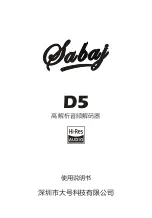
2
dc2138af
DEMO MANUAL DC2138A
Quick start proceDure
Demo circuit 2138A is easy to set up to evaluate the
performance of the LT8301. Refer to Figure 1 for proper
equipment setup and follow the procedure below.
1. With power off, connect the input power supply to the
board through VIN and GND terminals. Connect the
load to the terminals VOUT+ and VOUT– on the board.
2. Turn on the power at the input. Increase VIN slowly to
10V.
NOTE. Make sure that the input voltage is always within
spec. To operate the board with higher input/output
voltage, input capacitor, output capacitor and output
diode with higher voltage ratings are needed.
NOTE. To run overload tests on the demo board at high
line, additional RC snubber might be needed to make
sure the voltage spike at the switching node is always
less than 65V.
3. Check for the proper output voltages. The output should
be regulated at 5V (±5%).
NOTE. The LT8301 requires very small minimum load
to maintain good output voltage regulation. A Zener
diode is placed on the output to clamp the voltage to
~5V. This Zener is optional, and can be replaced with
a 0.8k resistor.
4. Once the proper output voltage is established, adjust
the input voltage and load current within the operating
range and observe the output voltage regulation, tran-
sient, ripple voltage, efficiency and other parameters.
NOTE. When measuring the input or output voltage
ripples, care must be taken to avoid a long ground lead
on the oscilloscope probe. Measure the input or output
voltage ripple by touching the probe tip directly across
the VIN or VOUT capacitor terminals. See Figure 2 for
proper scope probe technique.
Figure 1. Proper Measurement Equipment Setup
























